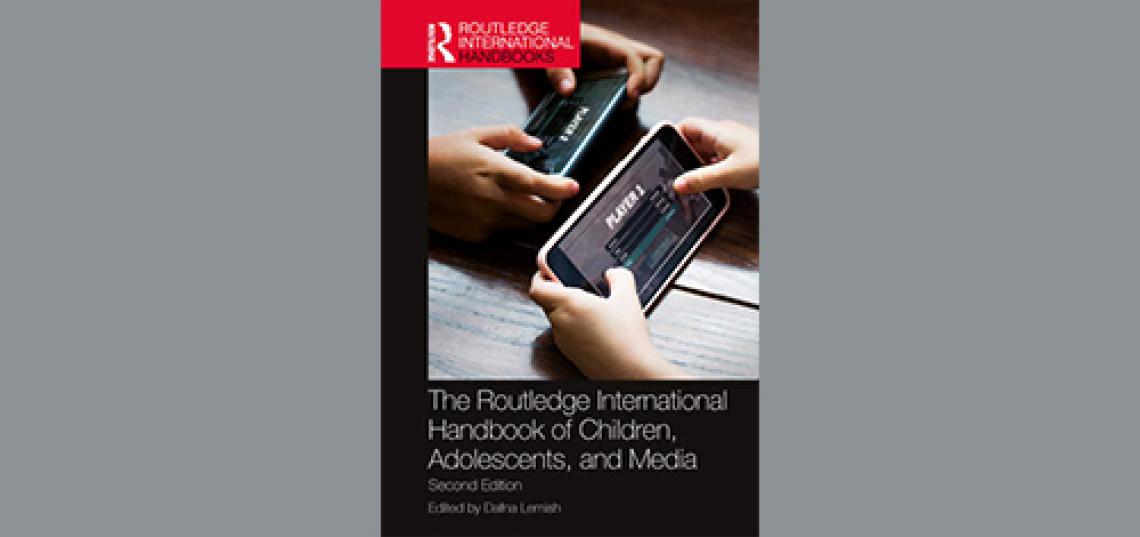
While the media – as channels of communication (including the internet and various social networks, video games, television, radio, newspapers, magazines, social robots, and more) – have the potential to greatly enrich children’s lives and development, at the same time they also have a great potential to damage and hinder children’s development, according to a newly published book.
Released on May 31, 2022, "The Routledge International Handbook of Children, Adolescents, and Media, Second Edition” includes 58 chapters of cutting-edge, multi-faceted, and important scholarship in the field of children, adolescents, and media, edited by SC&I’s Incoming Interim Dean and Distinguished Professor of Journalism and Media Studies Dafna Lemish.
It is important for everyone to be aware of the advantages and disadvantages of engagement of young people with media and how we can maximize their benefits and minimize their negative potential.
The volume explores the ways digital devices are now highly integrated in the everyday experiences and lived reality of children and adolescents worldwide and finds that as a result it is essential for people who care for or work with children to be knowledgeable and proactive in facilitating their media practices. The handbook’s authors also argue that doing so is a combined responsibility of the media industries, policy makers, parents and caregivers, educators, and the young people themselves.
The 90 contributing scholars from 18 countries focused on understanding the impacts of media on children from birth because even infants are exposed to media, to age 18, which is the age children are “commonly constructed in the literature as emerging adults,” Lemish said.
In addition to the diverse age range, Lemish said the children studied also represent a very diverse international group with widely different sets of needs, cognitive abilities, social and emotional experiences, life circumstances, gender, physical abilities and disabilities, and sexual orientation, in addition to their diversity in the areas of social class, religion, race and ethnicity, geography, and all the possible intersections between these.
Given the broad diversity among the children studied, Lemish said the researchers focused on different phases of childhood development to understand how children are exposed to --and use -- media during each phase.
As the second edition of the handbook, (the first edition was published a decade ago), Lemish said every chapter was revised and updated with current scholarship to reflect the dramatic changes in technology and society since 2013.
“In the decade that passed since the first edition came out, we witnessed dramatic changes in technological developments and in children’s engagement with media. There was a great need to bring the collection of articles up to date, so we added new chapters on topics such as media and mental health, digital inequalities, social robots, internet of toys, media and Muslim youths, media and children with disabilities, and a lot more,” Lemish said. The volume also includes a new afterward focused on the invisible children in media research, written by Lemish and SC&I Professor and Chair of Journalism and Media Studies Amy Jordan.
While the handbook was primarily written for an academic audience of students and scholars of media, sociology of childhood; developmental psychology; education; and related disciplines, Lemish said it will also be of interest to professionals in the media industries, policymakers, and parents, caregivers, and educators.
We added new chapters on topics such as media and mental health, digital inequalities, social robots, internet of toys, media and Muslim youths, media and children with disabilities, and a lot more.
While the book’s findings are especially timely in 2022, Lemish said the public discussion of the development of the “metaverse” – an immersive digital environment that may create even deeper shifts in the way children experience everyday reality– gives the handbook a particularly timely edge.
“Given that all people used to be children themselves, and most people interact with children on some level – whether as family members and caregivers, educators, or neighbors; and given the ubiquity of media in most people’s lives, it is important for everyone to be aware of the advantages and disadvantages of engagement of young people with media and how we can maximize their benefits and minimize their negative potential,” Lemish said.
Discover more about the Journalism and Media Studies Department at the Rutgers School of Communication and Information on the website.
